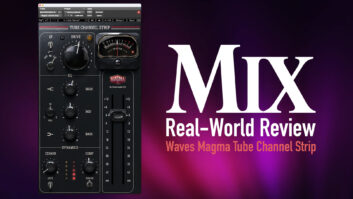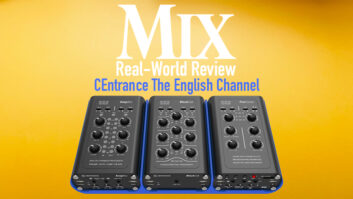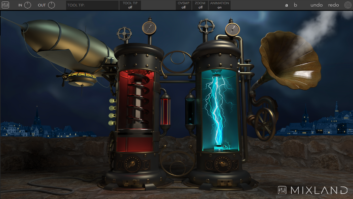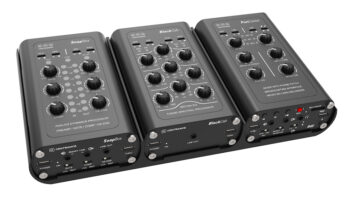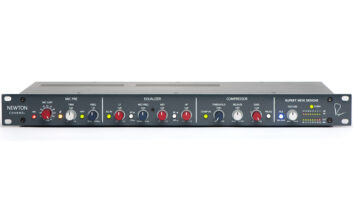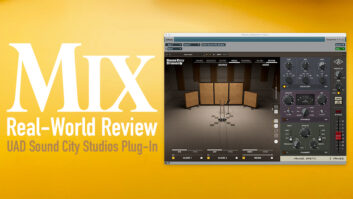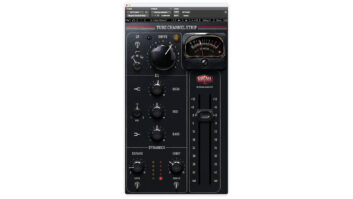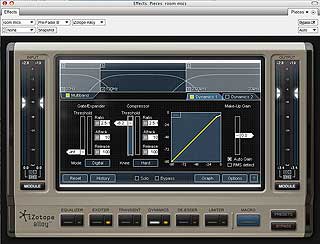
Alloy offers six different types of modules; some include more than one kind of processing. The dynamics module is shown here in Multiband mode.
Most channel strips include EQ, compression, phase inversion and perhaps limiting and gating. iZotope Alloy does all this and more, adding transient shaping, stereo widening, harmonic excitation, de-essing and phase rotation to the mix. Many of the processors offer a Multiband mode wherein you can apply processing independently in up to three frequency bands. Sidechaining, MacroPresets (stripped-down presets with simple controls) and an uncluttered GUI add to the appeal of this cross-platform Mac/PC plug-in. Alloy is available in Audio Units, RTAS, AudioSuite, VST, MAS and DirectX formats. I tested the MAS version of Alloy Version 1.01 in MOTU Digital Performer 6.02, using an 8-core 2.8MHz Mac Pro running Mac OS X 10.5.4.
Metal or Gas?
Alloy is to mixing what Ozone is to mastering, and users of either iZotope product will feel immediately at ease with the other due to their similarities. Alloy’s GUI is easy on the eye, thanks to its modular approach: The first module in the chain is an 8-band paragraphic equalizer, but you can freely re-order individual modules.
The equalizer offers seven different filter types for each band: low and high shelving, lowpass and highpass (both gentle- and sharp-sloped versions) and peak (bell-shape). Up to 15 dB of boost and 30 dB of cut is available for shelving and peak filters. You can use Alloy’s wide-ranging Q controls to implement both surgical notch filtering and broad tonal shaping. A defeatable soft-saturation option emulates the response of analog EQ at high signal levels.
Alloy’s Exciter module emulates the harmonic enhancement of vacuum tubes, analog tape and transistors. Or, you can select custom “bright” and “warm” settings that generate only even-numbered harmonics. Can’t decide which to use? Drag a cursor around an X/Y axis to create a blend of different types of excitation and adjust the number of harmonics generated. Choose Multiband mode and select a different type of exciter for each of two or three bands, adjusting the crossover frequencies to your liking. On stereo tracks, use Alloy to widen the stereo image independently in up to three frequency bands. Imagine widening the stereo image of a synth’s tube-processed high frequencies while collapsing its tape-flavored bottom end to mono.
The Shape I’m In
Use Alloy’s transient-shaper module to increase or decrease gain independently for a track’s attack and sustain portions. For example, you can boost the attack of a snare drum to enhance the stick hit while simultaneously decreasing its sustain to tighten up the sound. Or try tweaking the duration of the attack and sustain envelopes for a finer or broader point on kick drum hits.
Two independent dynamics modules can be chained in series or parallel. Each has a compressor and gate/expander with threshold, ratio, attack and release controls. The compressors can emulate the multistage release and program-dependent response of opto compressors or yield a more linear compression curve. The gate/expander includes upward-compression capabilities. You can apply processing in Multiband mode and trigger individual bands from an external source. For example, make bass guitar notes trigger compression of low frequencies in a kick drum track to tighten up the bottom end.
Alloy’s de-esser offers threshold, attack and release controls. Adjust the bandwidth of the frequency band to be processed. Then solo that band to home in on the sibilance.
Alloy offers soft and brickwall limiting. Both modes feature automatic makeup gain, making Alloy’s limiter also a maximizer. An accompanying phase tool does more than allow independent phase inversion for left and right channels of a stereo track. It also includes a zero-latency phase-rotation control that increases headroom by improving waveform symmetry.
Each module can be independently bypassed or solo’d and have its I/O levels adjusted. Alloy’s extensive metering tools include spectrum analysis for the equalizer and exciter modules; I/O, gain-reduction and curve-level meters for the dynamics section; and a limiter histogram. Sampling rates up to 192 kHz are supported. Comprehensive automation support, unlimited Undo history, a deep directory of presets and helpful A/B/C/D comparison tools add to Alloy’s allure. Pro Tools LE users will appreciate Alloy’s zero-latency mode, which prevents processed tracks from falling out of sync.
Mixing With Alloy
On a bass guitar track — with the equalizer set to boost the bottom end and roll off highs, and the exciter set to “warm” for frequencies below 190 Hz — the sound was a bit richer than what I started with. The real magic happened when I engaged Alloy’s brickwall limiter downstream, which made the bass sound huge and very even.
I tried adding sustain to the bass using Alloy’s transient shaper, but musical rests sometimes inexplicably resulted in a big jump in level on the first-following note’s attack, making the transient shaper unusable for this application. I got far superior (punchier) results on trap drums using other transient shapers — SPL Transient Designer and Waves TransX — instead of Alloy’s to pump up their attack. Alloy’s Shaper made a snare drum sound downright brittle.
That said, Alloy’s other modules in combination sounded phenomenal on room mics for drums. The compressor’s hard-knee mode, using an 8.2:1 ratio and fast attack/release times, produced an explosive sound. But by also widening the stereo image in the Exciter module, the sound was transformed into a bombastic monster!
Alloy’s equalizer sounded great on lead vocals, adding focus, roundness and shimmer. However, all but the sparest application of the exciter in midrange and HF bands tended to noticeably smear fricatives and sometimes caused loud clicks. (iZotope is aware of the problem and says it will address it in a future release.)
Alloy’s compressor — set to soft-knee, 3:1 ratio and moderate attack and release times — did a good job reining in the dynamic range of lead vocals without audible pumping. I did notice a slight loss of depth, however, which made it sound a tad thinner than results using the far more expensive Waves CLA-3A plug-in. Alloy’s de-esser worked phenomenally well. It removed sibilance so transparently and effectively that it has become my go-to de-esser for vocals.
On acoustic guitar, Alloy’s exciter sounded far too subtle for my tastes. The equalizer did a good job clearing up boominess and mud.
A Steel?
Alloy imposed negligible CPU drain on my 8-core Mac Pro. Its harmonic exciter and transient shaper both need improvement. But at the modest price of $249, Alloy is worth buying for its excellent de-esser, limiter, stereo widener, equalizer and compressors. There’s a lot to rave about.
Visit contributing editor Michael Cooper atwww.myspace.com/michaelcooperrecording.

Select summary to visit site.
